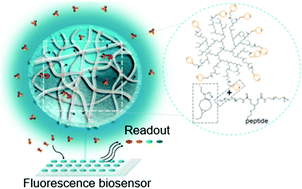Highly sensitive detection of antibodies in a soft bioactive three-dimensional bioorthogonal hydrogel†
Abstract
To this date, biosensing devices mainly based on two-dimensional (2D) assays such as enzyme-linked immunosorbent assay (ELISA) or 2D-microarrays are found on the market. In this article, we circumvent the drawbacks of 2D assays such as low loading capacity and protein denaturation, by producing a three-dimensional (3D) hydrogel array. As a proof of concept, we focus on antibody detection by peptides. A click reaction of polyethylene glycol (PEG) and dendritic polyglycerol (dPG) has produced one of the softest (G′ = 200 Pa) but relatively robust existing hydrogels comparable to cells. This customizable hydrogel is favorable for antibody diffusion and for peptide immobilization through bioorthogonal chemistry. An extensive study of the mechanical properties as a function of the PEG length has been conducted, which suggests, at both nano- and macro-scales, that an increase of the PEG length decreased the stiffness of the hydrogels and increased the mesh size, which correspondingly increased the diffusion rate of antibodies. The hydrogels exhibited a remarkable swelling ratio reaching up to 100 with a height expansion ratio up to 8. This specific and selective 3D model of detection has suggested a loading capacity seven times higher compared to 2D arrays, a higher sensitivity by 20% and a limit of detection up to 27 pg mL−1 for 3D assays setting the limits as low as that of other antibody binding methods such as ELISA, whereas the limit of detection for 2D slides is 0.5 μg mL−1.

- This article is part of the themed collection: 2019 Journal of Materials Chemistry B HOT Papers


 Please wait while we load your content...
Please wait while we load your content...